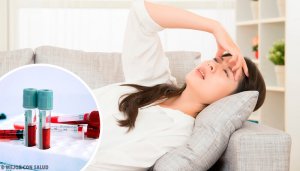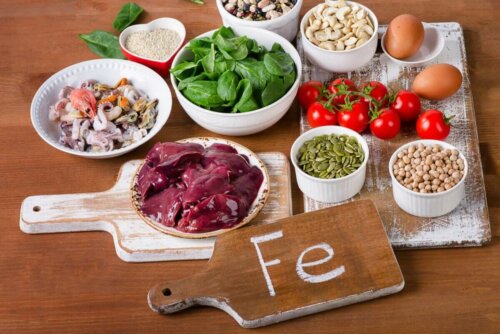Food that Promotes Normal Hemoglobin Levels


Written and verified by the doctor Nelton Abdon Ramos Rojas
We must all maintain normal hemoglobin levels in our blood so as to prevent anemia. The good news is some types of food can help you get all the nutrients you need.
Here are some healthy options, but before that, we will show you the basic things that you should know about this vital protein and how it functions in your body.
What is hemoglobin?
Hemoglobin is a protein that’s found inside your red blood cells. Furthermore, its function is to move oxygen from your lungs to your tissues, and carbon dioxide (CO2) from your tissues to your lungs.
Hemoglobin levels are different between men and women. In men, normal levels are 13.8 or 14 g/dl, while for women normal levels are 12.1 or 15 g/dl. When a woman is pregnant, her hemoglobin levels should be at or above 11.0 g/dl.
However, for children, the levels vary depending on their age. Therefore, it’s very important that their levels are normal for healthy growth:
- Firstly, children six months to four years: 11 g/dl
- Then, from 5-12 years: 11.5 g/dl
- Finally, from 12-15 years: 12.0 g/dl or more
Hemoglobin and anemia
Hemoglobin is the most valued reference to diagnose anemia. When hemoglobin levels are below the normal values, you could be anemic. Furthermore, this is because the deficiency of this protein is directly related to iron deficiency. However, as you may know, this could cause you to suffer from iron deficiency anemia (iron reduction in your body).
Hemoglobin is what gives your blood its red color. In addition, it has important functions for your body, which is why it should maintain stable levels.
Therefore, to know and control your hemoglobin levels, you can do a blood test. This is called a hemogram, or “blood count.” Furthermore, to do this, they measure all of the components of your blood. In addition, it also isn’t good to have high hemoglobin levels because this could also cause severe damage.
Your hemoglobin levels depend on a proper diet, as well as regular exercise. However, these aren’t the only factors that can change your hemoglobin levels.
Read about Cervicogenic Dizziness: Causes and Remedies
Effects of low hemoglobin levels

When hemoglobin is low, something isn’t right with health. Therefore, it’s common for the person to experience discomfort and some difficulty in carrying out their routine. Among the most common causes are the following:
- Anemia
- Radiation therapy
- Heavy menstruation
- Leukemia and various types of cancer
- Iron-deficiency anemia due to lack of iron (this is caused by poor iron absorption or not following a balanced diet)
Symptoms
- Fatigue
- Dizziness
- Weakness
- Tiredness
- Pale skin
- Chills
- Hypersomnia
- Irritability
- Headaches
- Weight loss
- Arrhythmia problems from an irregular heartbeat
- Difficulty breathing
- Difficulty concentrating
Effects of high hemoglobin levels
On the other hand, when your hemoglobin levels are too high, you should be alert. After all, it could be an indicator of more serious health problems. So, next, we’ll tell you some possible causes:
- Meningitis
- Smoking
- Dehydration
- Heart problems
- Brain tumors
- Lung problems
- Use of certain medications
- A stroke, especially one caused by a cardiovascular accident
Symptoms

- Dizziness
- Itchiness
- Burning or stinging
- Abdominal pain
- Excessive bleeding
- Swelling of the spleen
- Difficulty breathing
- Issues with blood clotting
- Changes in skin color
What to eat for normal hemoglobin levels

A balanced diet is able to provide the body with all the nutrients it needs to stay healthy. However, when your body doesn’t have enough iron, it takes it from other sources. As a result, hemoglobin production drops. However, in these cases, the consumption of foods rich in iron and other nutrients is recommended, as we will see below.
1. Food rich in iron
- Liver
- Seafood
- Spinach
- Beans
- Beef
- Tree nuts, especially almonds
- Vegetables, especially those with a dark green color
2. Food with folic acid
- Seeds
- Walnuts
- Broccoli
- Spinach
- Asparagus
- Peanuts
- Beef liver
- Black-eyed peas
- Wheat germ
- Fortified cereals
3. Food with vitamin C
- Cabbage
- Strawberries
- Broccoli
- Mangos
- Oranges
- Bell peppers
- Spinach
- Mandarins
4. Food with vitamin B-12
- Animal products
- Fortified cereals
Fruit juice is great for raising hemoglobin levels
It’s popularly said you should drink certain natural beverages (mainly juices) to maintain good hemoglobin levels. So, some of the most common options are citrus fruit juice (orange, lemon, etc.) and beet juice.
- The vitamin C in citrus fruits facilitates the absorption of iron in your body. For this reason, these juices are recommended.
- In addition, beet juice is recommended, as this is a food that provides a certain amount of potassium, proteins, fiber, and folates.
Herbs with special properties
According to popular beliefs, some herbs can be included in your diet to raise hemoglobin. So, some of the most recommended are:
- Dandelion: you can eat these flowers in salads or teas
- Dill is good for when hemoglobin is low due to blood loss. Furthermore, grind the seeds and use them as a condiment in other foods.
- Nettle contains a lot of iron and vitamins. Therefore, naturally, this makes it a great food to raise hemoglobin levels. Furthermore, you can eat its leaves in salads.
Types of food that alter your hemoglobin levels
However, not all foods are good to eat when you are trying to maintain an adequate amount of hemoglobin. Therefore, you should avoid foods that could inhibit your body from absorbing iron. Some of them are sodas, teas, parsley, milk, coffee, antacids, and foods with a lot of calcium and fiber. Furthermore, you should avoid consuming antacids.
Gluten can damage the lining of your small intestine in people that are sensitive to gluten. Furthermore, it can cause a deterioration in the absorption of nutrients like iron and folic acid, among others.
Consult with your doctor about which foods you should exclude from your diet and which foods you can occasionally eat. At the same time, maintain a balanced diet and enjoy all the benefits it has for your health.
All cited sources were thoroughly reviewed by our team to ensure their quality, reliability, currency, and validity. The bibliography of this article was considered reliable and of academic or scientific accuracy.
- Giardina B, Messana I, Scatena R, Castagnola M., “The multiple functions of hemoglobin”, Crit Rev Biochem Mol Biol. 1995;30(3):165-96.
- Bilbao Garay, Javier (2006). «Anemias carenciales I: anemia ferropénica». Inf Ter Sist Nac Salud (en inglés) (Madrid: Ministerio de Sanidad y Consumo. Subdirección General de Calidad de Medicamentos y Productos Sanitarios) 30 (2): 35-41.
- Auerbach, Michael; Adamson, John W. (enero de 2016). «How we diagnose and treat iron deficiency anemia» [Cómo diagnosticamos y tratamos la anemia por deficiencia de hierro]. American Journal of Hematology (en inglés) (John Wiley & Sons, Inc) 91 (1): 31-3
This text is provided for informational purposes only and does not replace consultation with a professional. If in doubt, consult your specialist.








